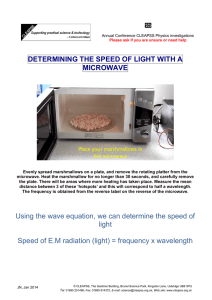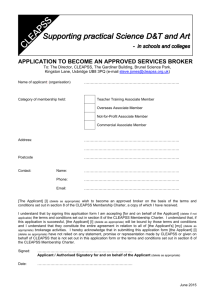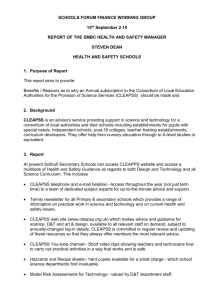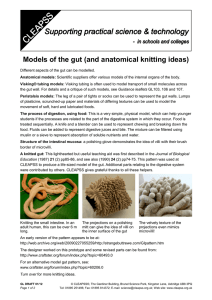GUIDANCE ON CLEAPSS SERVICES FOR TRAINEE TEACHERS
advertisement
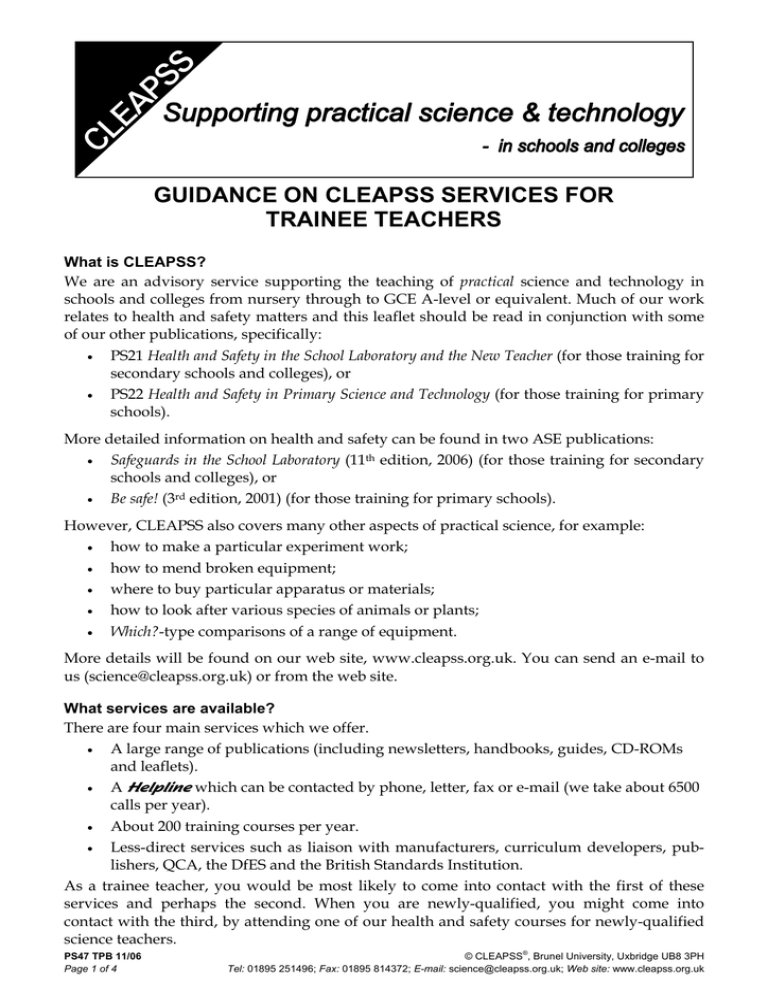
GUIDANCE ON CLEAPSS SERVICES FOR TRAINEE TEACHERS What is CLEAPSS? We are an advisory service supporting the teaching of practical science and technology in schools and colleges from nursery through to GCE A-level or equivalent. Much of our work relates to health and safety matters and this leaflet should be read in conjunction with some of our other publications, specifically: • PS21 Health and Safety in the School Laboratory and the New Teacher (for those training for secondary schools and colleges), or • PS22 Health and Safety in Primary Science and Technology (for those training for primary schools). More detailed information on health and safety can be found in two ASE publications: • Safeguards in the School Laboratory (11th edition, 2006) (for those training for secondary schools and colleges), or • Be safe! (3rd edition, 2001) (for those training for primary schools). However, CLEAPSS also covers many other aspects of practical science, for example: • how to make a particular experiment work; • how to mend broken equipment; • where to buy particular apparatus or materials; • how to look after various species of animals or plants; • Which?-type comparisons of a range of equipment. More details will be found on our web site, www.cleapss.org.uk. You can send an e-mail to us (science@cleapss.org.uk) or from the web site. What services are available? There are four main services which we offer. • A large range of publications (including newsletters, handbooks, guides, CD-ROMs and leaflets). • A Helpline which can be contacted by phone, letter, fax or e-mail (we take about 6500 calls per year). • About 200 training courses per year. • Less-direct services such as liaison with manufacturers, curriculum developers, publishers, QCA, the DfES and the British Standards Institution. As a trainee teacher, you would be most likely to come into contact with the first of these services and perhaps the second. When you are newly-qualified, you might come into contact with the third, by attending one of our health and safety courses for newly-qualified science teachers. PS47 TPB 11/06 Page 1 of 4 ® © CLEAPSS , Brunel University, Uxbridge UB8 3PH Tel: 01895 251496; Fax: 01895 814372; E-mail: science@cleapss.org.uk; Web site: www.cleapss.org.uk Who pays? CLEAPSS is basically a membership organisation. At the time of writing, all of the 180 local authorities in England, Wales, Northern Ireland and the various islands are members of CLEAPSS. (A sister organisation, SSERC, operates in Scotland.) This means that the staff of all local-authority schools have free access to our services. In addition, almost all independent, foundation and voluntary-aided schools and incorporated colleges subscribe directly, as associate members, or receive our services via a local authority. Similarly, virtually all teacher-training establishments that offer science are associate members. What is my entitlement to CLEAPSS services as a trainee? If you are doing teaching practice in a school that is a member of CLEAPSS (as almost all are) there is no problem - you have the same access as any other member of staff. Similarly, if the establishment at which you are doing your training is a member, there is equally no problem. However, we do need to check that you are entitled to our services. If you write to us by post, you must do so from your school or college address, not a home address, so we can check membership. Similarly by e-mail; some e-mail addresses allow us to identify the establishment easily, but not all. If you phone, we will question you about your school or college. If we are sending publications, it will only be to an identifiable school or college address. Can I use the Helpline as a trainee? Subject to us being satisfied that you are in a member school or college, yes, you are entitled to use the Helpline. However, we are NOT able - or willing - to carry out your assignments for you! If you want to know a safe way of carrying out the thermite reaction or whether particular glues are suitable for use by children at Key Stage 1 we will happily deal with your enquiry. But if your question is more about the benefits of the national curriculum or child development, then that is outside our remit. We don’t think it is very helpful to receive enquiries such as “I am doing a project on animals. Please send me all you have”. Questions need to be more sharply focused - remember, our remit is practical science in schools, not an encyclopaedic knowledge of all science. We do have a range of publications about keeping animals. Do you want to know about which species are suitable for keeping in schools? What are their nutritional requirements? What about caging? It would be best to visit our web site (www.cleapss.org.uk) first, to see what we publish, and then find out if publications of interest are available already in your school or college. If necessary, phone us to discuss how to obtain publications and which one(s) might be most useful - or indeed fill in gaps. What publications might be useful to me and how do I obtain them? CLEAPSS produces a very large number of publications, usually aimed at primary or secondary schools, although some cover both. The lists on the following pages are very selective - longer lists appear on our web site, www.cleapss.org.uk. Publications with the Lor R- prefix are stapled, A4 booklets, typically 20 or so pages long, but sometimes up to 70 pages. The PS-series consists of leaflets, usually 3 or 4 pages long. Most publications for secondary schools are available on a CD-ROM (see below). One copy of our publications for primary schools, and new secondary-school publications, is free to relevant establishments. Some are sent out automatically; for others, schools need to request them. There is a charge for paper copies of secondary-school publications already on the CDROM. The publication belongs to the school or college, not to an individual teacher. PS47 TPB 11/06 Page 2 of 4 ® © CLEAPSS , Brunel University, Uxbridge UB8 3PH Tel: 01895 251496; Fax: 01895 814372; E-mail: science@cleapss.org.uk; Web site: www.cleapss.org.uk Sometimes, lecturers suggest that particular CLEAPSS publications would be helpful for an assignment. If so, we would expect the publication already to be available in the establishment’s library. We are not able to supply multiple free copies for individual students but a teacher-training establishment can ask for permission to photocopy for its own internal use by students. Alternatively, those for secondary schools could be accessed via the CD-ROM. As indicated above, you may indeed find that in some teacher-training establishments copies of our publications are kept in the library. Alternatively, they may go into a science room, laboratory or prep room. If you cannot track them down, contact our Helpline to find out to whom we send them - and, indeed, to check that your establishment is a paid-up member. The following periodicals may be especially useful. • The CLEAPSS Bulletin (intended for secondary schools and colleges and sent out termly to such establishments and to teacher-training establishments, about a week after the start of the school term). (Those published since 1990 are on the CD-ROM.) • The Primary Science and Technology Newsletter (intended for primary schools and sent out termly to such schools and to teacher-training establishments, about a month after the start of the school term). For both of these, an Index, updated each term, is available and also published on our web site. The following guides may be helpful for those training to teach in all types of school. • L52 Small Mammals • L56 Housing and Keeping Animals • L71 Incubating and Hatching Eggs • L197 Giant African Land Snails • L201 Giant Millipedes • L206 Tadpoles • L213 Science with Minibeasts: Snails • L221 Developing and Using Environmental Areas • L226 Carnivorous Plants • L227 Stick Insects If you are training for primary teaching, in addition, the following are a selection of the guides that may be useful. • L5p Safe Use of Household and Other Chemicals • L18 Glues and Adhesives • L42 Plants for Classrooms • L86p Electrical Safety • L112 Batteries and LV units; which to buy? • L120p Earth Science: Key Stages 1 and 2 • L122p Simple Electric Circuits with Bulbs and Batteries • L157p Measuring Temperature • L163 Teaching Forces • L161 Magnets for Primary Schools • L181 Cold Water Aquaria • L190 Studying Microorganisms in Primary Schools PS47 TPB 11/06 Page 3 of 4 ® © CLEAPSS , Brunel University, Uxbridge UB8 3PH Tel: 01895 251496; Fax: 01895 814372; E-mail: science@cleapss.org.uk; Web site: www.cleapss.org.uk • • • • • L198 Earth in Space: Key Stages 1 and 2 L204 Science for Primary-aged Pupils with Motor Difficulties L241 Teaching Health and Safety in Primary Schools L245 Ourselves PS55 Bringing Pets and other Animals into Schools If you are training for secondary schools, the following are some of our publications to watch out for. • CLEAPSS Science Publications CD-ROM: This includes all the publications listed below and many more. There are several files only available in electronic form. These include E229 Illustrations of Basic Laboratory Equipment, E230s Teaching about Electrical Circuits, E232 Common Safety Signs and Hazard Symbols, E243 and E244 Food Chain Mobiles and E252 the CLEAPSS Font (allowing you to print common safety signs). E229 and E232 allow you to print poster-size illustrations in colour or black and white, or to paste them into worksheets. The CD can be put onto school networks or copied onto teachers’ laptops. An updated version is produced in December every year. • Hazcards: A5-size cards giving health and safety information about the most commonly used chemicals and examples of their typical safe use in school science. • Student Safety Sheets: photocopiable sheets intended for use by Key Stage 4 and 6thform students, giving information about hazards and risks in biology, chemistry and physics. • CLEAPSS Laboratory Handbook: a massive (1000 page) reference manual in one or more blue binders (but now often only accessed on the CD-ROM). It covers health & safety legislation, guidance on how to do many practical activities and many other pieces of information. It is seen as a technicians’ Bible - but there is a huge amount of relevant material for teachers, too. The following guides and leaflets are some of those useful for individuals training for secondary teaching (and can be found on the CD). • L77 Science for Secondary-aged Pupils with Special Educational Needs • L93 Managing Ionising Radiations and Radioactive Substances • R135 Eye and Face Protection • L195 Safer Chemicals, Safer Reactions • L202 Spectra • L215 Microscale Organic Chemistry • L238 Health & Safety Induction and Training of Science Teachers • PS1 Pond Dipping and Weil’s Disease • PS34 Microbiology Activities in Spotlight Science • PS44 The CASE Project: Safety and Resources • PS64 Are we allowed to … ? (Biology FAQs) • PS66b Getting Started with the CLEAPSS CD-ROM • PS67 Practical Activities in the New Science GCSEs • PS69 Banned Chemicals and Other Myths CLEAPSS, Brunel University, Uxbridge UB8 3PH. Tel: 01895 251496 Fax: 01895 814372 E-mail: science@cleapss.org.uk Web site: www.cleapss. org.uk PS47 TPB 11/06 Page 4 of 4 ® © CLEAPSS , Brunel University, Uxbridge UB8 3PH Tel: 01895 251496; Fax: 01895 814372; E-mail: science@cleapss.org.uk; Web site: www.cleapss.org.uk
